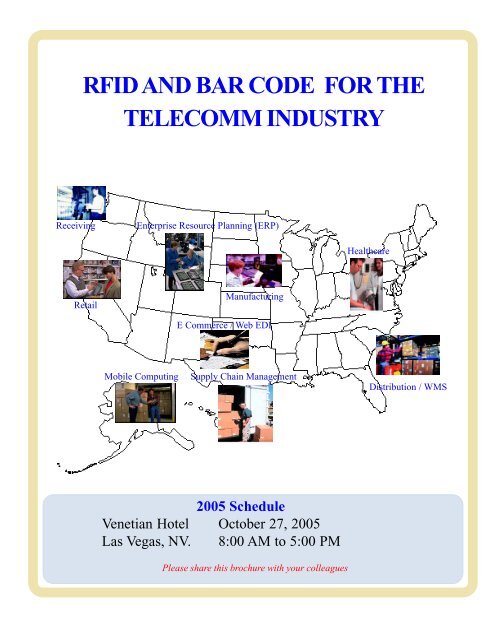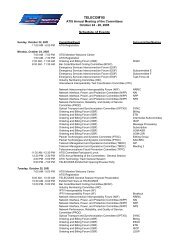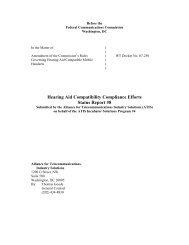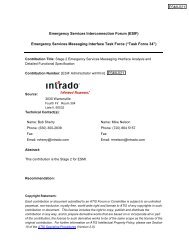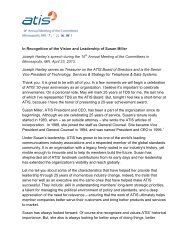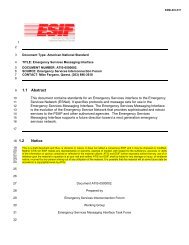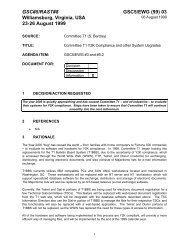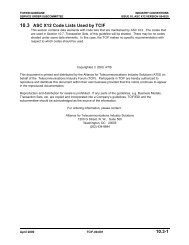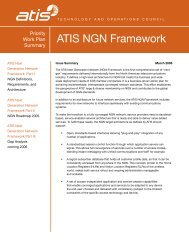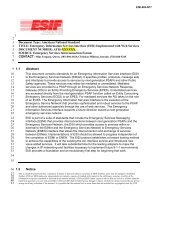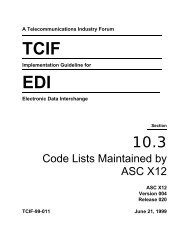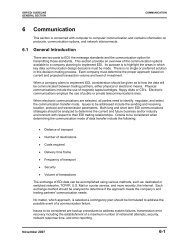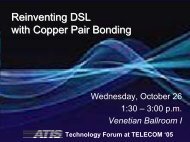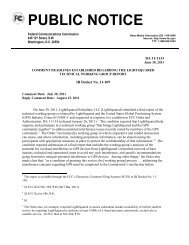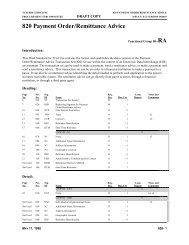RFID AND BAR CODE FOR THE TELECOMM INDUSTRY - ATIS
RFID AND BAR CODE FOR THE TELECOMM INDUSTRY - ATIS
RFID AND BAR CODE FOR THE TELECOMM INDUSTRY - ATIS
Create successful ePaper yourself
Turn your PDF publications into a flip-book with our unique Google optimized e-Paper software.
<strong>RFID</strong> <strong>AND</strong> <strong>BAR</strong> <strong>CODE</strong> <strong>FOR</strong> <strong>THE</strong><br />
<strong>TELECOMM</strong> <strong>INDUSTRY</strong><br />
Receiving<br />
Enterprise Resource Planning (ERP)<br />
Healthcare<br />
Retail<br />
Manufacturing<br />
E Commerce / Web EDI<br />
Mobile Computing<br />
Supply Chain Management<br />
Distribution / WMS<br />
2005 Schedule<br />
Venetian Hotel October 27, 2005<br />
Las Vegas, NV. 8:00 AM to 5:00 PM<br />
Please share this brochure with your colleagues
COURSE DESCRIPTION:<br />
This seminar will show how <strong>RFID</strong>, UID “Unique Identification”,<br />
bar code and other automatic identification and<br />
data collection (AIDC) technologies are used to enhance<br />
the entire enterprise. It will also show how to design and<br />
integrate automatic data collection technologies into your<br />
applications. This educational course is also designed to<br />
show how to understand and implement UID “Unique<br />
Identification”, EPC “Electronic Product Code” and <strong>RFID</strong><br />
into your supply chain. UID and <strong>RFID</strong> have been mandated<br />
by the Department of Defense for all their suppliers<br />
to enhance their global supply chain.<br />
These technologies will be used in central office, warehousing,<br />
distribution and the manufacturing environments to improve the<br />
efficiency of the overall operation and to create a competitive<br />
advantage. Bar code combined with <strong>RFID</strong> technologies provides<br />
one of the most accurate and timely means of data collection in use<br />
today. For example, it has been determined that manual data entry<br />
has an average error rate of 1 error in 300 characters compared to<br />
bar code data collection, which is 1 error in several million characters.<br />
It is not uncommon to have inventory accuracy in the high<br />
nineties by utilizing these technologies, along with reducing excess<br />
carrying costs by 25%. The course will cover traditional 1D (linear<br />
bar codes), 2D and matrix symbologies, <strong>RFID</strong>, UID, standards,<br />
hardware, implementation techniques and practical applications<br />
within the telecommunications industry.<br />
Note: Seminars can also be held on-site or on-line using<br />
WEBEX.<br />
WHO SHOULD ATTEND?<br />
Free Self Paced CDs:<br />
As part of the course you will receive a work book and<br />
training CDs. The CDs contain a self paced course,<br />
which your company can use to educate their staff. ($195<br />
value)<br />
<strong>RFID</strong> and Bar Code in the Telecomm Industry<br />
Seminar:<br />
With increased pressure from local and global competition<br />
and the need for industry compliance, businesses are<br />
looking for ways to enhance their productivity and lower<br />
manufacturing, warehousing and distribution costs.<br />
Telecommunications service providers (phone companies)<br />
also need an accurate picture of their asset base for<br />
accurately costing and pricing telephone services. To meet<br />
these challenges organizations are turning to <strong>RFID</strong> and<br />
Bar Code automatic identification and data collection<br />
systems. If your organization wants to increase productivity<br />
and learn the latest data collection technologies, this<br />
course is for you. This educational course is designed to<br />
show you how to understand and implement data collection<br />
technologies, like bar code and <strong>RFID</strong> in the telecommunications<br />
industry.<br />
Anyone involved in the implementation, management or use of<br />
bar code and other automatic identification and data collection<br />
applications. These include, but are not limited, to the following<br />
personnel:<br />
- VP of Operations<br />
- Material Management<br />
- Quality Assurance<br />
- Production<br />
- Packaging Engineering<br />
- Asset Tracking<br />
- Logistics- Distribution<br />
- Inventory<br />
- Procurement Managers<br />
- Warehousing<br />
- Central Office<br />
- Transportation<br />
- Management Information Systems<br />
- Industrial/Design Engineering<br />
- Supply Chain Management<br />
- Product Engineering/Management<br />
COURSE LEADERS:<br />
Two industry experts, Robert Fox and Robert W.<br />
Rylander are the course leaders. They are industry<br />
leaders with a combined total of more than 35 years’ experience in<br />
the AIDC industry.
Module 1- Understanding Radio Frequency<br />
Identification <strong>RFID</strong><br />
Advantages:<br />
<strong>RFID</strong> tags speeds the collection of data in dirty, oily, wet<br />
or harsh commercial as well as industrial environments.<br />
<strong>RFID</strong> continues to emerge as a major automatic identification<br />
technology. <strong>RFID</strong> is often embedded in systems<br />
with other technologies, such as bar code and RFDC data<br />
collection. Unlike bar code, <strong>RFID</strong> tags are virtually<br />
impossible to copy. The technology is ideal for confidential<br />
identification of people or assets. <strong>RFID</strong> is fast: Tags<br />
and readers communicate in some cases up to 1000 times<br />
per second. <strong>RFID</strong> will read through dirt, paint and<br />
cement. Learn how <strong>RFID</strong> works and whether to select a<br />
Passive or Active system. Select the right reader and<br />
transponder for your application.<br />
How <strong>RFID</strong> Works:<br />
What is <strong>RFID</strong>?<br />
Wireless Communication and Air Interface<br />
Frequency / Data Read Rate / Applications<br />
Transponders/Tags<br />
Active Tags<br />
Semi-Active / Semi-Passive Tags<br />
Passive Tags<br />
Storage Capacity<br />
Environmental Controls<br />
Anti-Collision Capability<br />
Readers Configurations<br />
Duplicate Removal<br />
Smart Label Printers<br />
<strong>RFID</strong> Standards<br />
Programming<br />
Physical Packaging<br />
Applications for <strong>RFID</strong>:<br />
Warehouse Management<br />
Yard Management<br />
MODULE 2 - Symbology Overview 1D / 2D /<br />
Matrix<br />
There will be a historical review of symbologies and an<br />
overview of complementary automatic identification<br />
technologies. The most popular linear and 2D Stacked/<br />
Matrix symbologies, which are in use throughout the<br />
world, will be covered in detail.<br />
Linear Symbologies<br />
- Code 39 - Code 11 - EAN & UPC<br />
- Code 128 - Interleaved 2 of 5<br />
2D and Matrix Symbologies<br />
- PDF 417 - MaxiCode<br />
- Data Matrix - Composite Codes<br />
- Micro PDF417 - TLC39<br />
Module 3- Printing Techniques for <strong>RFID</strong> Smart<br />
Labels and bar codes<br />
Selection of the proper printing technology for your<br />
application is imperative for successful implementation of an<br />
<strong>RFID</strong> / bar code system. Explore the options of producing<br />
media on-site or through a service bureau. Learn a variety of<br />
technologies used to create the <strong>RFID</strong> tags / bar codes labels,<br />
direct marking and select the best technology for your<br />
application.<br />
Dot Matrix<br />
Thermal Direct and Transfer<br />
<strong>RFID</strong> Smart tag printing Laser<br />
Direct Marking Ink Jet<br />
Portable Printers Pre Printed labels (InfoDot)<br />
Module 4 - Scanning and Data Collection Terminals<br />
A major decision is the selection of the right type of scanning<br />
and data collection devices for a particular application. How<br />
these devices function in order to capture vital information<br />
will be covered within this module. Also covered will be all<br />
of the major data collection terminals and scanning methods,<br />
which are in use today and how they are used in various<br />
applications. RFDC 802.11 and Bluetooth and Infrared technologies<br />
will be covered in detail.<br />
Scanning Technologies<br />
Fundamentals<br />
Wand<br />
Image Technology<br />
Industrial Scanners<br />
Data Collection Terminals<br />
Decode Functions<br />
CCD<br />
Laser<br />
RFDC Terminals<br />
802.11 / Blue Tooth / Infrared<br />
RF site survey and Access Point locations<br />
Shop Floor Terminals<br />
<strong>RFID</strong> / Bar Code Readers<br />
Hand Held<br />
Fixed<br />
PDA Technologies<br />
<strong>RFID</strong> Workshop<br />
Testing of Tags on various Packaging
GR-383-CORE and the <strong>ATIS</strong> Product Marking Implementation<br />
Guideline, <strong>ATIS</strong>-0300038. A discussion of the issues with label<br />
layout, how to create the 2-D symbols, including using the ANSI<br />
MH10.8.3 (ISO/IEC 15434) syntax. The session provides a walkthrough<br />
of the product marking documents and guidelines. You<br />
will also learn about the product package, shipping and cable reel<br />
labels specified by the industry in the <strong>ATIS</strong> Implementation Guide<br />
for Package Labeling, <strong>ATIS</strong>-0300006. The end of plug-in card<br />
package label, which allows a 2D symbol containing the package<br />
information, will also<br />
be discussed.<br />
Module 5- Verification of 1D/ 2D / Matrix<br />
codes / <strong>RFID</strong><br />
Most bar code application standards today require<br />
verification of a bar code label in accordance with the<br />
ISO/IEC 15415 and ANSI X3.182 Print Quality Guideline.<br />
This is in order to obtain the highest readability of<br />
the bar code. You will learn why and how to establish a<br />
bar code verification program within your organization.<br />
Label Placement Primary<br />
2D Verification Workshop<br />
Failure Causes<br />
Corrective Actions<br />
Module 6- Understanding the Electronic<br />
Product Code and the DOD UID (Unique<br />
Identifcation)<br />
The structure of EPC<br />
The Savant<br />
ONS (Object Name Server)<br />
PLM (Physical Markup Language<br />
What is UID?<br />
Who is required to adhere to UID<br />
Data, Application and Text elements<br />
UID structure/constructs<br />
Recommended telecommunications<br />
Industry Constructs<br />
DOD <strong>RFID</strong> Structures<br />
MODULE 7 – LABELING OVERVIEW<br />
Telecommunications service providers (“telephone<br />
companies”) will be accepting 2-D symbols (without an<br />
additional linear bar code) on products by April 1, 2006<br />
Equipment manufacturers need to mark their equipment<br />
and service providers need to prepare ALL their systems<br />
(hardware and software) NOW to receive the data from<br />
the 2-D symbols. Some manufacturers are already<br />
shipping products with 2-D labels. You will learn the<br />
details of creating both linear and 2-D telecommunications<br />
product labels per the Telcordia document:<br />
MODULE 8 - GLOBAL ST<strong>AND</strong>ARDS<br />
Are your customers requiring you to adhere to bar code standards?<br />
Learn the latest retail and industrial standards, which are now<br />
being used. Learn how to take advantage of the industrial, retail<br />
and telecommunications standards for product, package and<br />
shipping applications. The most popular global standards will be<br />
reviewed.<br />
- ANSI MH10.8.3 (ISO/IEC 15434) – Transfer Syntax for High<br />
Capacity ADC Media<br />
- ANSI MH10.8.2 (ISO/IEC 15418) - Data Application Identifier<br />
Standard<br />
- <strong>ATIS</strong>-0300005 - Product Identification Coding Schemes<br />
- TCIF-98-005 - Product Serialization Guideline<br />
- CEA-802 - Product Marking Standard<br />
- <strong>ATIS</strong>-0300038 - Product Marking Implementation Guideline<br />
- Telcordia GR-383-CORE (for CLEI code labels)<br />
- ANSI MH10.8.1 - Linear bar code and two-dimensional symbols<br />
used in shipping, receiving, and transport applications<br />
- CEA-556 - Outer Shipping Container Bar Code Label Standard<br />
- <strong>ATIS</strong>-0300006 - Implementation Guide for Package Labeling<br />
- <strong>ATIS</strong>-0300044 - Guidelines for the Identification and Bar Code<br />
Labeling of Cable Reels<br />
- <strong>ATIS</strong>-0300045 - Machine-readable Manifest Guidelines for Cable<br />
Reels<br />
MODULE 9 - POTENTIAL APPLICATIONS / CASE<br />
STUDIES – IN <strong>THE</strong> <strong>TELECOMM</strong>UNICATIONS IN-<br />
DUSTRY<br />
You will learn AIDC solutions used in the telecommunications<br />
industry:<br />
- Receiving - Document Tracking<br />
- Inventory - Shipping<br />
- Network equipment asset management<br />
- Network equipment maintenance<br />
- Network Equipment Inventory<br />
- <strong>RFID</strong> in dispatch, inventory & asset management
Three case studies will portray the opportunity, the<br />
solution and benefits obtained from an AIDC system.<br />
Learn the approach these companies used and the types of<br />
equipment selected for their application.<br />
- Telecommunication equipment manufacturer implementation<br />
- Telephone service provider implementation<br />
- Repair vendor implementation<br />
Module 10 - Cost Justification<br />
AIDC systems in general have a very high return on<br />
investment (ROI). Learn the techniques that companies<br />
use to justify the implementation of AIDC systems. Learn<br />
how to prepare a cost justification analysis.<br />
- Return on Investment Analysis<br />
- <strong>RFID</strong> cost benefit cost analysis<br />
- Justifying 2D labeling and scanning (<strong>ATIS</strong> Cost/Benefit<br />
Estimating Work sheet)<br />
Biographical Sketch of your Instructor<br />
Robert W. Rylander is President<br />
of Robert W. Rylander and Associates<br />
and has worked in the<br />
Automatic Identification industry<br />
for the past twenty years. He is a<br />
membor of the AIDC (Automatic Identification / Data<br />
Capture) 100 professional organization. Seven years with<br />
Symbol Technologies Inc. as Senior Manager of Consulting<br />
Services for the Worldwide Education Group and<br />
prior to that Senior Consultant, INTERMEC Corporation.<br />
He has worked in manufacturing for over 23 years and<br />
has held managerial positions in the Quality Assurance<br />
field for several large corporations. During the period that<br />
he was in manufacturing, he managed the implementation<br />
of Shop Floor and Inventory bar code systems for ITT,<br />
Storage Technology, and Digital Equipment Corporation.<br />
For the past several years, he has consulted for over two<br />
hundred industries in the development of Bar Code<br />
Strategic Plans and Bar Code Standards. Mr. Rylander<br />
was awarded first place in the Materials Handling<br />
Institutes, “Concepts for the 80’s”, for his total live shop<br />
floor control and bar code concepts. Conducts seminars<br />
and bar code workshops for several organizations and<br />
universities. He has been a member of the EIA standard<br />
committee for several years, responsible for developing<br />
standards for the Electronics Industry. For the past twelve<br />
years he has conducted bar code workshops in the Pacific<br />
Rim countries of Japan, Singapore, Malaysia and Hong<br />
Kong.Robert has just completed a UID CD training<br />
program for the Department of Defense<br />
Robert H. Fox<br />
Robert H. Fox has been involved with<br />
bar codes and automatic identification<br />
for the past 17 years. He currently<br />
provides consulting services for the<br />
implementation of automatic identifica<br />
tion systems for telephone companies<br />
and equipment manufacturers. He<br />
chairs the telecommunications industry<br />
(<strong>ATIS</strong> – the Alliance for Telecommunications Industry<br />
Solutions) Bar Code/Standard Coding Committee<br />
(BCSC), which develops AIDC guidelines for product,<br />
package and shipping labels. He also participates on the<br />
Consumer Electronics Association (CEA) Automatic Data<br />
Capture Committee, which sets national standards for bar<br />
code usage for the electronics industry, on the ANSI<br />
MH10 Subcommittee 8, which sets national material<br />
handling labeling standards and on the U.S. Technical<br />
Advisory Group for international standards for bar code<br />
print quality, data structure, radio frequency identification<br />
(<strong>RFID</strong>) and equipment conformance. Mr. Fox has<br />
provided guidelines for specifying and selecting bar code<br />
label materials and print technology, as well as specifications<br />
and training to telecommunications companies to<br />
incorporate bar code technology; procure bar code labels;<br />
select bar code scanners, portable data collectors and bar<br />
code printers for several tracking and inventory projects.<br />
He is currently leading the telecommunications industry<br />
on a new initiative to explore the uses and benefits of<br />
<strong>RFID</strong> technology in the telecommunications supply chain.<br />
He has written a white paper on <strong>RFID</strong> for the Telecommunication<br />
Industry.<br />
Fees: $350.00<br />
10% discount for one of the following:<br />
1. Three or more attendees from the same company.*<br />
2. Registration 30 days prior to the seminar date.*<br />
* Registration forms received on or after September 29, will be<br />
charged the full rate of $350.<br />
Cancellations:<br />
A registered participant may receive a refund of the fee paid, minus a<br />
ten dollar ($10) processing fee, if <strong>ATIS</strong> is notified in writing of the<br />
cancellation prior to ten (10) calendar days from the start of the<br />
meeting. Address cancellation notifications to Veronica Lancaster,<br />
BCSC Committee Administrator via email at vlancaster@atis.org or<br />
via US Postal Mail at <strong>ATIS</strong>, 1200 G Street, NW, Suite 500, Washington,<br />
DC 20005. Substitutions may take place at any time with written<br />
notification to <strong>ATIS</strong> regarding the substitution. Address substitution<br />
notifications to Veronica Lancaster, BCSC Committee Administrator<br />
via email at vlancaster@atis.org or via US Postal Mail at <strong>ATIS</strong>, 1200<br />
G Street, NW, Suite 500, Washington, DC 20005.<br />
Fees Include:<br />
- Course Materials<br />
- Training CD and Workbook<br />
- Continental Breakfast and Lunch<br />
- Completion Certificate
<strong>RFID</strong> and Bar Code for the<br />
Telecommunications Industry<br />
SEMINAR REGISTRATION <strong>FOR</strong>M<br />
Las Vegas, Nevada<br />
October 27, 2005<br />
Last Name First Name Telephone #<br />
Company<br />
Address City State Zip Code<br />
Fax#<br />
E-Mail Address<br />
NOTE: IN <strong>THE</strong> EVENT YOU NEED TO CANCEL, PLEASE SEE <strong>THE</strong> CANCELLATION POLICY BELOW.<br />
*10% discount for early registration! Must register before COB September 28, 2005 to receive this discount!<br />
Early Registration Fee<br />
*10% discount for three or more attendees from the same company!<br />
Registration Fee (3 rd or more person from same company)<br />
Registration Fee After September 28, 2005<br />
$332.00 per person<br />
$332.00 per person<br />
$350.00 per person<br />
$_______ Total Conference Fee<br />
Payment:<br />
Check (payable to <strong>ATIS</strong>) American Express MasterCard Visa<br />
Credit Card No.<br />
Expiration Date<br />
Authorized Signature<br />
(Physical Signature Required!)<br />
V Code: ______ (last 3 digits in the signature box on the back of your credit card) Required for MasterCard and Visa<br />
Please send payment to:<br />
Alliance for Telecommunications Industry Solutions (<strong>ATIS</strong>)<br />
1200 G Street, NW, Suite 500<br />
Washington, DC 20005<br />
Attention: Veronica Lancaster<br />
Phone: (202) 434-8826<br />
Fax: (202) 393-5467<br />
Deadline for Registering with <strong>ATIS</strong>: September 28, 2005<br />
ADA Compliance: It is the policy of <strong>ATIS</strong> to ensure that all of our activities are accessible to qualified persons with disabilities in accordance with the Americans with Disabilities Act.<br />
If you need special accommodations to fully participate, please provide a written description and attach.<br />
Cancellation Policy: A registered participant may receive a refund of the fee paid, minus a ten dollar ($10) processing fee, if <strong>ATIS</strong> is notified in writing of the<br />
cancellation prior to ten (10) calendar days from the start of the meeting. Address cancellation notifications to: <strong>ATIS</strong>, 1200 G Street, NW, Suite 500, Washington, DC<br />
20005.


